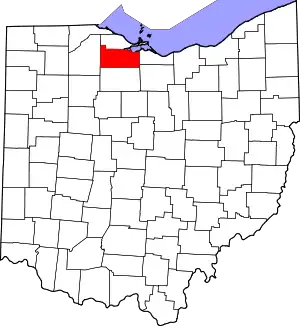Fremont, Ohio
Fremont is a city in and the county seat of Sandusky County, Ohio, United States, along the Sandusky River. It is about 35 miles (56 km) southeast of Toledo and 25 miles (40 km) west of Sandusky.[5] The population was 15,930 at the 2020 census.
Fremont, Ohio | |
|---|---|
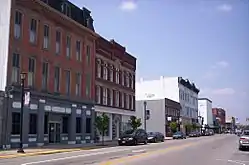 Downtown Fremont, Ohio on South Front Street | |
 Logo | |
| Nickname: Cutlery Capital of the World[1] | |
| Motto: "Where People Come First" | |
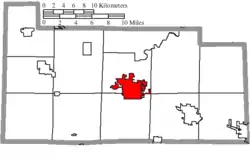 Location of Fremont in Sandusky County | |
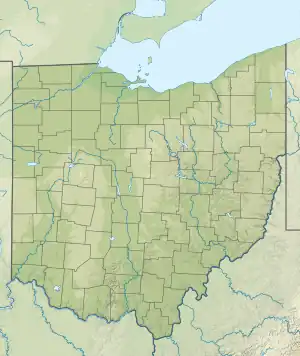 Fremont  Fremont | |
| Coordinates: 41°20′56″N 83°7′2″W | |
| Country | United States |
| State | Ohio |
| County | Sandusky |
| Township | Ballville, Sandusky |
| Government | |
| • Mayor | Danny Sanchez (R) |
| Area | |
| • Total | 8.74 sq mi (22.64 km2) |
| • Land | 8.52 sq mi (22.07 km2) |
| • Water | 0.22 sq mi (0.57 km2) |
| Elevation | 627 ft (191 m) |
| Population (2020) | |
| • Total | 15,930 |
| • Density | 1,869.28/sq mi (721.70/km2) |
| Time zone | UTC-5 (Eastern (EST)) |
| • Summer (DST) | UTC-4 (EDT) |
| ZIP code | 43420 |
| Area code(s) | 419, 567 |
| FIPS code | 39-28826[4] |
| GNIS feature ID | 1040674[3] |
| Website | www |
The city was the home of Rutherford B. Hayes, who served as President of the United States from 1877 to 1881. The Rutherford B. Hayes Presidential Center was the first presidential library and is one of the focal points of the city. The National Arbor Day Foundation has designated Fremont as a Tree City USA since 1986.[6]
History
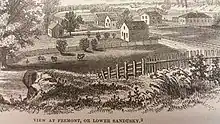
Fremont is located on the former site of Junquindundeh, an historic Wyandot village on the west bank of the lower Sandusky River, near the falls and about 15 miles (24 km) upstream from its mouth at Sandusky Bay. French merchants established a trading post there in the 1750s, but British forces took over the trading post and rest of the area after their victory in the French and Indian War.
In 1787, the newly independent United States created the Northwest Territory to include all land west of the Ohio River. In 1803 the southeastern portion of the Northwest Territory was admitted to the Union as the new state of Ohio. Under the terms of Ohio's statehood, the area of Lower Sandusky was defined as Indian Territory. American settlers who entered the area were in violation of the 1795 Treaty of Greenville, which was meant to preserve at least some land for the Native Americans. During the War of 1812 the United States Army considered removing by force the white settlers who were violating the Treaty of Greenville, but they did not carry out the threat.[8]
Tensions with Great Britain increased in the early 1800s, and the United States government declared a boycott on all trade with the British, including those in Canada. The U.S. Army built Fort Sandusky near the river to protect an important supply depot. The post's name was changed to Fort Stephenson during the War of 1812. In August 1813, British forces attacked and the Battle of Fort Stephenson took place.[9] Major George Croghan and his U.S. Army garrison successfully fought off the invaders.
With the return of peace, a settlement grew up around the fort and became known as Lower Sandusky, since it was located on the lower part of the Sandusky River. In 1821 Lower Sandusky was designated as the county seat of Sandusky County. The town gradually increased in size, with the primary occupations being shipbuilding, fishing, and agricultural processing. Sandusky Bay leads to Lake Erie, and there was good fishing for walleye in the river, which return annually to spawn upriver. By the 1830s, the population included more white settlers, despite the area being a declared reserve only for Native Americans. Numerous Wyandot people still lived in the area, and some runaway African American slaves had made it their home after reaching safety in the free state of Ohio. The city had grain and sawmills, and the first sugar mill in Ohio.[8]
In 1849 the residents changed the name of Lower Sandusky to Fremont, to honor John C. Frémont, who helped acquire California during the Mexican–American War.[10]
In 1873, a few years before gaining national office, future president Rutherford B. Hayes moved into a family mansion in Fremont called Spiegel Grove, which was built by his late maternal uncle. That year Hayes announced his uncle Sardis Birchard's bequest in his will, donating property in his estate worth $50,000 to the City Council in order to establish a public library. It opened the following year on Front Street. A few years later, a new building was constructed for it in 1878 on the grounds of the Fort Stephenson State Park, per his bequest. It is now known as the Birchard Public Library of Sandusky County. Spiegel Grove was incorporated into the Rutherford B. Hayes Presidential Center, founded in 1916 as the first presidential library in the United States.[8]
In the late 19th and early 20th centuries, Fremont became a major center for the production of cutlery, with several manufacturing plants, as well as other industries. The cutlery industry has declined, but the city still has a large Heinz plant for producing ketchup. In 1999, the ketchup factory saw a $40 million expansion.[11]
Commemoration of Battle of Fort Stephenson
The city set aside Fort Stephenson Park to preserve and commemorate the site of the fort that had a role in the War of 1812. Only its stone foundations are still visible. In 1885 the Sandusky County Soldiers Monument was installed in the park near Croghan Street, which was named after the commanding major of the fort. (He was promoted to colonel afterward for his success.) Former president Rutherford B. Hayes attended the ceremony.
In 1906 Colonel Croghan's remains were brought from his hometown in Kentucky to Fremont and reinterred under the Soldiers Monument. In the same ceremony, the Daughters of the American Revolution (DAR) unveiled a plaque to the Soldiers Monument to commemorate Croghan and his garrison in their victory in the Battle of Fort Stephenson.
What is now the main building of the Birchard Public Library, which serves the entire county, was constructed in 1878 in Fort Stephenson Park, by the terms of the bequest from Sardis Birchard, who bequeathed $50,000 in assets to endow a public library in 1873. The first facility opened in 1874 in a building on Front Street.[12]
Geography
Fremont is located on both sides of the Sandusky River.
The city has a total area of 8.57 square miles (22.20 km2), of which 8.35 square miles (21.63 km2) is land and 0.22 square miles (0.57 km2) is water.[13]
Climate
| Climate data for Fremont, Ohio, 1991–2020 normals, extremes 1901–present | |||||||||||||
|---|---|---|---|---|---|---|---|---|---|---|---|---|---|
| Month | Jan | Feb | Mar | Apr | May | Jun | Jul | Aug | Sep | Oct | Nov | Dec | Year |
| Record high °F (°C) | 73 (23) |
75 (24) |
86 (30) |
93 (34) |
96 (36) |
107 (42) |
110 (43) |
105 (41) |
105 (41) |
93 (34) |
80 (27) |
72 (22) |
110 (43) |
| Mean maximum °F (°C) | 56.2 (13.4) |
58.8 (14.9) |
69.9 (21.1) |
80.9 (27.2) |
88.3 (31.3) |
93.6 (34.2) |
94.6 (34.8) |
93.8 (34.3) |
91.3 (32.9) |
83.3 (28.5) |
69.2 (20.7) |
59.9 (15.5) |
96.2 (35.7) |
| Average high °F (°C) | 33.7 (0.9) |
36.6 (2.6) |
46.7 (8.2) |
59.9 (15.5) |
71.5 (21.9) |
81.1 (27.3) |
85.0 (29.4) |
82.9 (28.3) |
76.8 (24.9) |
64.1 (17.8) |
50.3 (10.2) |
38.8 (3.8) |
60.6 (15.9) |
| Daily mean °F (°C) | 26.1 (−3.3) |
28.3 (−2.1) |
37.3 (2.9) |
48.9 (9.4) |
60.4 (15.8) |
70.4 (21.3) |
74.0 (23.3) |
72.0 (22.2) |
65.2 (18.4) |
53.2 (11.8) |
41.5 (5.3) |
31.6 (−0.2) |
50.7 (10.4) |
| Average low °F (°C) | 18.5 (−7.5) |
20.0 (−6.7) |
27.8 (−2.3) |
38.0 (3.3) |
49.5 (9.7) |
59.7 (15.4) |
63.1 (17.3) |
61.0 (16.1) |
53.6 (12.0) |
42.4 (5.8) |
32.8 (0.4) |
24.5 (−4.2) |
40.9 (4.9) |
| Mean minimum °F (°C) | −2.1 (−18.9) |
2.5 (−16.4) |
11.6 (−11.3) |
24.9 (−3.9) |
34.9 (1.6) |
45.8 (7.7) |
52.2 (11.2) |
49.9 (9.9) |
40.4 (4.7) |
29.2 (−1.6) |
19.0 (−7.2) |
8.1 (−13.3) |
−4.5 (−20.3) |
| Record low °F (°C) | −20 (−29) |
−17 (−27) |
−5 (−21) |
6 (−14) |
27 (−3) |
38 (3) |
44 (7) |
34 (1) |
30 (−1) |
19 (−7) |
0 (−18) |
−17 (−27) |
−20 (−29) |
| Average precipitation inches (mm) | 2.73 (69) |
2.42 (61) |
2.81 (71) |
3.83 (97) |
3.80 (97) |
4.10 (104) |
3.63 (92) |
3.37 (86) |
3.23 (82) |
2.91 (74) |
2.77 (70) |
2.60 (66) |
38.20 (970) |
| Average snowfall inches (cm) | 8.4 (21) |
6.9 (18) |
3.7 (9.4) |
1.0 (2.5) |
0.0 (0.0) |
0.0 (0.0) |
0.0 (0.0) |
0.0 (0.0) |
0.0 (0.0) |
0.0 (0.0) |
0.9 (2.3) |
5.3 (13) |
26.2 (66.2) |
| Average precipitation days (≥ 0.01 in) | 12.2 | 10.1 | 10.6 | 12.6 | 12.9 | 11.2 | 10.3 | 8.9 | 9.1 | 10.1 | 10.2 | 10.7 | 128.9 |
| Average snowy days (≥ 0.1 in) | 6.2 | 5.1 | 2.3 | 0.4 | 0.0 | 0.0 | 0.0 | 0.0 | 0.0 | 0.0 | 0.8 | 3.4 | 18.2 |
| Source 1: NOAA[14] | |||||||||||||
| Source 2: National Weather Service[15] | |||||||||||||
Demographics
| Census | Pop. | Note | %± |
|---|---|---|---|
| 1830 | 351 | — | |
| 1840 | 1,117 | 218.2% | |
| 1850 | 1,464 | 31.1% | |
| 1860 | 3,510 | 139.8% | |
| 1870 | 5,455 | 55.4% | |
| 1880 | 8,440 | 54.7% | |
| 1890 | 7,141 | −15.4% | |
| 1900 | 8,439 | 18.2% | |
| 1910 | 9,939 | 17.8% | |
| 1920 | 12,468 | 25.4% | |
| 1930 | 13,422 | 7.7% | |
| 1940 | 14,710 | 9.6% | |
| 1950 | 16,537 | 12.4% | |
| 1960 | 18,767 | 13.5% | |
| 1970 | 18,490 | −1.5% | |
| 1980 | 17,887 | −3.3% | |
| 1990 | 17,648 | −1.3% | |
| 2000 | 17,375 | −1.5% | |
| 2010 | 16,734 | −3.7% | |
| 2020 | 15,930 | −4.8% | |
| 2021 (est.) | 15,821 | −0.7% | |
| Sources:[4][16][17][18] | |||
2010 census
As of the census[19] of 2010, there were 16,734 people, 6,745 households, and 4,162 families residing in the city. The population density was 2,004.1 inhabitants per square mile (773.8/km2). There were 7,541 housing units at an average density of 903.1 per square mile (348.7/km2). The racial makeup of the city was 80.7% White, 8.3% African American, 0.2% Native American, 0.3% Asian, 5.3% from other races, and 5.1% from two or more races. Hispanic or Latino people of any race were 16.1% of the population.
There were 6,745 households, of which 34.2% had children under the age of 18 living with them, 37.1% were married couples living together, 18.7% had a female householder with no husband present, 5.9% had a male householder with no wife present, and 38.3% were non-families. 32.5% of all households were made up of individuals, and 12% had someone living alone who was 65 years of age or older. The average household size was 2.42 and the average family size was 3.04.
The median age in the city was 35.3 years. 27.2% of residents were under the age of 18; 8.6% were between the ages of 18 and 24; 25.7% were from 25 to 44; 24.7% were from 45 to 64; and 13.9% were 65 years of age or older. The gender makeup of the city was 47.8% male and 52.2% female.
2000 census
As of the census[4] of 2000, there were 17,375 people, 6,856 households, and 4,374 families residing in the city. The population density was 2,313 inhabitants per square mile (893/km2). There were 7,368 housing units at an average density of 980.9 per square mile (378.7/km2). The racial makeup of the city was 82.24% White, 8.29% African American, 0.18% Native American, 0.24% Asian, 5.85% from other races, and 3.19% from two or more races. Hispanic or Latino people of any race were 12.32% of the population.
There were 6,856 households, out of which 33.6% had children under the age of 18 living with them, 42.5% were married couples living together, 16.4% had a female householder with no husband present, and 36.2% were non-families. 30.4% of all households were made up of individuals, and 12.8% had someone living alone who was 65 years of age or older. The average household size was 2.46 and the average family size was 3.06.
In the city the population was spread out, with 27.6% under the age of 18, 10.0% from 18 to 24, 28.7% from 25 to 44, 19.3% from 45 to 64, and 14.4% who were 65 years of age or older. The median age was 34 years. For every 100 females, there were 89.9 males. For every 100 females age 18 and over, there were 85.0 males.
The median income for a household in the city was $34,051, and the median income for a family was $39,439. Males had a median income of $32,453 versus $22,048 for females. The per capita income for the city was $16,014. About 9.8% of families and 12.9% of the population were below the poverty line, including 16.8% of those under age 18 and 9.9% of those age 65 or over.
Economy
The world's largest ketchup plant, operated by Heinz is located in Fremont, producing 80% of the ketchup sold in the United States.[20][21] At one time the city was home to several cutlery companies: the Christy Company, Clauss Cutlery Company, Quikut, B.A.P. Manufacturing, the Ginsu Cutlery Line, and Herbrand tools. It was also home to a Pioneer Sugar processing plant which closed in 1997, but as of 2020, remains a Michigan Sugar warehouse,[22] despite plans in 2009 to open an ethanol refinery plant on the site.[23]
Arts and culture
.jpg.webp)
Landmarks
- Birchard Public Library (built in a park at the former site of Fort Stephenson)
- H. J. Heinz Company ketchup factory (the world's largest ketchup factory)
- Rutherford B. Hayes Presidential Center
- Sandusky County Jail and Sheriff's House
- Spiegel Grove
- Fremont Speedway
- The Strand Concert Theater
Historic downtown Fremont
Downtown Fremont is located next to the Sandusky River on Front Street. Front Street has a pedestrian scale and is home to many small businesses in historic buildings: they include boutiques, gift shops, restaurants, and other attractions. Downtown Fremont has been the center of the city for many years.
Government
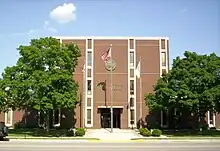
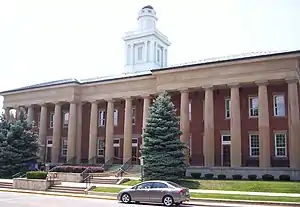
| Mayor | Daniel R. Sanchez | Republican |
| President of Council | Jamie Hafford | Independent |
| Auditor | Paul D. Grahl | Democrat |
| Law Director | James F. Melle | Democrat |
| Treasurer | Holly R. Elder | Democrat |
| Council At Large | Kristine Weiss | Republican |
| Council At Large | John S. Elder | Democrat |
| Council At Large | Denis Otte | Republican |
| 1st Ward Council | Justin C. Smith | Republican |
| 2nd Ward Council | James S. Sleek | Democrat |
| 3rd Ward Council | Angie Ruiz | Democrat |
| 4th Ward Council | Christopher E. Liebold | Democrat |
| Municipal Judge | Daniel L. Brudzinski | Republican |
Education
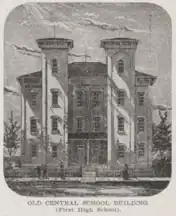
Public education is provided by the Fremont City School District, which enrolls 3,519 students in public primary and secondary schools.[24] The district administers four elementary schools, one middle school, and one high school, Fremont Ross. The city is also home to Vanguard-Sentinel Career and Technology Centers, offering career-specific college level classes, Bishop Hoffman Catholic Schools, affiliated with the Roman Catholic Diocese of Toledo, which serves students in grades preschool through 12 and includes Saint Joseph Central Catholic High School for grades nine through 12. Another private school for grades preschool through grade 12, Temple Christian Academy, is operated by Fremont Baptist Temple.[25] The first public school was erected in 1816.[26]
Terra State Community College, a two-year community college founded in 1968, is located on a 143-acre (58 ha) campus in the western part of the city. It has an enrollment of approximately 2,400 students, mainly from Sandusky, Seneca, and Ottawa counties.
Fremont has a public library, a branch of the Birchard Public Library of Sandusky County.[27]
Media
Fremont's daily newspaper is The News-Messenger. WFRO-FM (99.1 FM) "Eagle 99" broadcasts from Fremont.
Infrastructure
Transportation
Two long-distance US routes run through Fremont, U.S. Route 6 and U.S. Route 20. State Routes 12, 19, 53 and 412 also pass through or terminate in the Fremont area. SR 53 roughly parallels the path of the Sandusky River, designated as a state scenic river, to its mouth at Sandusky Bay.
None of these routes passes through Fremont but were constructed outside. They are multiplexed on a bypass of the city, most of which is 4 lanes. The bypass has both grade-level crossings and controlled-access interchanges. Prior to completion of the bypass in the late 1950s, all of these routes passed through Fremont. Their former alignments are currently signed as "City Route (number)", with the number being that of the predecessor highway.[28]
The Ohio Turnpike, another long-distance east–west route, passes approximately 4 miles north of the city. The Turnpike is signed as Interstates 80 and 90. Exit 91 (originally Exit 6) links the Turnpike to Fremont via State Route 53.
Industry is served by the Norfolk Southern railroad. In the city, it uses parts of two defunct railroads as spurs to factories.
Notable people
- Margret Holmes Bates (1844-1927), author
- Alycia Baumgardner, model, professional boxer and champion in the World Boxing Council and International Boxing Organization
- Tom Beier, professional football player in the National Football League (NFL), All-American in college football
- Bob Brudzinski, professional football player in the NFL
- Clarence Childs, member of 1912 US Olympic team, bronze medalist in the hammer throw
- Mark Coleman, mixed martial artist in Ultimate Fighting Championship (UFC), member of UFC Hall of Fame, member of 1992 US Olympic wrestling team
- Everton Conger, capturer of John Wilkes Booth
- Dana DeMuth, professional umpire in Major League Baseball
- Paul Dietzel, head coach in college football
- Doug Gallagher, professional baseball player in Major League Baseball
- Andy Genzman, racing driver
- Robert W. Hines, national wildlife artist for the U.S. Fish and Wildlife Service
- Alice E. Johnson, architect
- Carla F. Kim, Associate Professor of Genetics at Harvard Medical School
- Robert Knepper, actor, role of "T-Bag" in the Prison Break television series
- Tony Little, television fitness personality
- Rob Lytle, professional football player in the NFL, member of College Football Hall of Fame
- Shawn McCarthy, professional football player in the NFL
- Walter R. Nickel, dermatologist
- Myles Porter, member of 2012 US Paralympic Team, silver medalist in judo
- Gary Shilling, financial analyst and commentator
- Bob Snyder, professional football player and head coach in the NFL
- Diane Wray Williams, Minnesota state legislator, businesswoman, and teacher
- Charles Woodson, professional football player in the NFL, Heisman Trophy winner, and member of Pro Football Hall of Fame
- Jacob Wukie, member of the 2012 US Olympic team, silver medalist in recurve archery
References
- Sandusky County Historical Society. "Fremont Native Charles Stilwell: Inventor of the Self-Opening Sack". Archived from the original on July 9, 2010. Retrieved September 5, 2010.
- "ArcGIS REST Services Directory". United States Census Bureau. Retrieved September 20, 2022.
- "US Board on Geographic Names". United States Geological Survey. October 25, 2007. Retrieved January 31, 2008.
- "U.S. Census website". United States Census Bureau. Retrieved January 31, 2008.
- "Find a County". National Association of Counties. Archived from the original on May 31, 2011. Retrieved June 7, 2011.
- Ohio
- Lossing, Benson (1868). The Pictorial Field-Book of the War of 1812. Harper & Brothers, Publishers. p. 500.
- "Fremont, Ohio". Ohio History Central. Retrieved December 27, 2013.
- Gilpin, Alec R. (1958). The War of 1812 in the Old Northwest (1968 reprint ed.). East Lansing, MI: The Michigan State University Press. p. 207.
- Gannett, Henry (1905). The Origin of Certain Place Names in the United States. Govt. Print. Off. pp. 132.
- "OHIO; FREMONT TO BE KETCHUP CAPITAL". Dayton Daily News. May 21, 1999. p. 8B. ProQuest 254187212.
- "Birchard Library" Archived 2018-08-04 at the Wayback Machine, Birchard Public Library of Sandusky County website, Ohio, 2018
- "US Gazetteer files 2010". United States Census Bureau. Archived from the original on July 2, 2012. Retrieved January 6, 2013.
- "U.S. Climate Normals Quick Access – Station: Fremont, OH". National Oceanic and Atmospheric Administration. Retrieved March 8, 2023.
- "NOAA Online Weather Data – NWS Cleveland". National Weather Service. Retrieved March 8, 2023.
- "Number of Inhabitants: Ohio" (PDF). 18th Census of the United States. U.S. Census Bureau. 1960. Retrieved April 24, 2020.
- "Ohio: Population and Housing Unit Counts" (PDF). U.S. Census Bureau. Retrieved November 22, 2013.
- "Fremont city, Ohio". census.gov. Retrieved June 29, 2022.
- "U.S. Census website". United States Census Bureau. Retrieved January 6, 2013.
- Charles, Dan (September 2, 2019). "Meet The Man Who Guards America's Ketchup". National Public Radio. Retrieved September 3, 2019.
- Lindeman, Teresa (April 17, 2007). "Fremont, Ohio: A visit to the heart of Heinz". Pittsburgh Post-Gazette. Retrieved November 8, 2020.
- "Our Story - Michigan Sugar". Michigan Sugar. Retrieved November 8, 2020.
- Brickey, Homer (June 28, 2007). "Fremont Ethanol Plant Has Twist". The Blade. Retrieved November 8, 2020.
- "Fall Enrollment (Headcount) - October 2017 Public Districts and Buildings". Enrollment Data. Ohio Department of Education. October 2017. Retrieved May 4, 2018.
- "Home". Temple Christian Academy. 2018. Retrieved May 4, 2018.
- Meek, B., editor. (1909) . Chicago, Richmond-Arnold publishing co. [Pdf] Retrieved from the Library of Congress, https://www.loc.gov/item/13023471/.
- "Branches". Birchard Public Library. Retrieved March 3, 2018.
- Gulyas, Sandor (December 8, 2003). "Fremont Photos". The Ohio Regional Road Pages. Retrieved July 1, 2013.
Further reading
- Hurt, R. Douglas. The Ohio Frontier: Crucible of the Old Northwest, 1720–1830. Bloomington, IN: Indiana University Press, 1996.
External links
- City website
- Fremont, Ohio, at Ohio History Central
- Fremont, Ohio at Curlie
- Downtown Fremont - News & Information about Downtown Fremont and the City
- Rutherford B. Hayes Presidential Library & Museums
